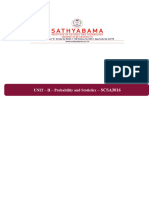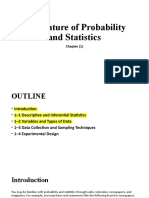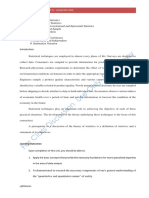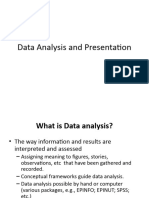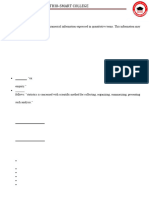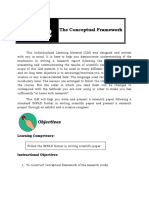Lecture Notes 1
Uploaded by
mi5180907Lecture Notes 1
Uploaded by
mi5180907Lecture 1
1- The Nature of Probability and Statistics
1-1 Descriptive and Inferential Statistics
Statistics is the science of conducting studies to collect, organize, summarize, analyze, and draw
conclusions from data.
Data can be used in different ways. Statistics is divided into two main areas, depending on how
data are used:
1- Descriptive statistics consists of the collection,
organization, presentation, and summarization of Statistical
Methods
data.
2- Inferential statistics consists of generalizing from
samples to populations, performing estimations and
Descriptive
hypothesis tests, determining relationships among Statistics Statistics
variables, and making predictions.
A population consists of all subjects (human or otherwise) that are being studied.
A sample is a group of subjects selected from a population.
Types of Descriptive Statistics: Descriptive
Statistics
1- Measure of central tendency:
Mean, Median, Mode,
Midrange and Weighted Mean
Measures of Measures of Measures of
2- Measure of variation: Central Variation Position
Range, Variance, Standard Tendency
Deviation and Coefficient of Variation
3- Measure of position:
Standard Score, Percentiles, Quartiles, Deciles and Outliers.
PHM111s - Probability and Statistics
There are two major divisions of inferential statistics:
1- A confidence interval gives a range of values
for an unknown parameter of the population by Statistics
measuring a statistical sample.
2- Tests of significance or hypothesis
testing where scientists make a claim about the
population by analyzing a statistical sample.
The data is summarized by the researcher, in a useful way, with the help of numerical and
graphical tools such as charts, tables, and graphs, to represent data in an accurate way.
Moreover, the text is presented in support of the diagrams, to explain what they represent.
1-2 Variables and Types of Data
Data are the values (measurements or observations) that the variables can assume.
Different Types of Data:
A variable can be defined as a characteristic that can take different values (e.g. measures of
temperature, height, weight, cost and gender) unlike Constants which are characteristics that have
values that do not change (e.g. pi (π) = 3.14159… and e = 2.71828….)
Variables can be classified as qualitative or quantitative:
1- Qualitative variables are variables that can be
expressed not in terms of numbers, but rather by
means of a natural language description, according
to some characteristic or attribute.
For example: gender (male or female), beauty of Qualitative Quantitative
variables variables
individual, intelligence of people, …
PHM111s - Probability and Statistics
Qualitative variables can be further classified into two groups: ordinal and nominal:
i) A categorical variable whose categories can be meaningfully ordered is called ordinal
variable. For example: size (small, medium, large, etc.), Attitudes (strongly disagree,
disagree, neutral, agree, strongly agree), a student's grade in an exam (A, B, C or Fail) are
ordinal variables.
ii) When it does not matter which way the categories are ordered in tabular or graphical
displays of the data (i.e. all orderings are equally meaningful), we call them nominal
categories. For example: a student's religion (Atheist, Christian, Muslim, Hindu), gender,
or sport.
2- Quantitative variables are numerical and can be ordered or ranked. For example, the
variable age is numerical, and people can be ranked in order according to the value of their
ages. Other examples of quantitative variables are heights, weights, and body temperatures.
Quantitative variables can be further classified into two groups: discrete and continuous:
i) A variable whose values are generally countable is called discrete. For example: the
number of books, marks in examination.
ii) A variable that may contain any value within some range is called continuous. It can
take integral and fractional values both. For example: height, weight, length, time, etc.
So, in addition to being classified as qualitative or quantitative, variables can be classified by how
they are categorized, counted, or measured as in the following chart:
PHM111s - Probability and Statistics
Qualitative Quantitative
(Categorical variables) (Numerical variables)
Ordinal Nominal Discrete Continuous
variables variables variables variables
1-3 Data Collection and Sampling Techniques
The method of collecting data is considered one of the
most important phases that statistical research mainly
depends on. Collecting data in such scientific methods
will lead to get accurate outcomes when doing
Primary Secondary
operations of statistical inference and proper decision Data Data
making.
Resources of collecting data
1- Primary resources (Field resources):
These are the resources which we originally get data such as interviewing or questionnaires. This
type is distinguished by accuracy. However, it needs time and efforts beside it is highly expensive
to conduct such a type.
PHM111s - Probability and Statistics
2- Secondary resources (historical resources):
We can get our data from authorities and agencies formally work such as central agency for public
mobilization and statistics, internet and media. This type is a good type of resources such that it
saves time and money.
Methods of collecting data
The method of collecting data is determined according to the aim and the size of the statistical
society under study.
For example: The students of a faculty represent a statistical society whose value is the student.
1. Method of mass population:
It means to collect the data related to the phenomenon of the statistical society. It's used to include
all the society such as the population. This type is including all the values. It’s unbiased and the
outcomes are so accurate.
The disadvantages of such a method are: it needs long time and great efforts. Furthermore, it
costs much money.
2. Methods of samples:
It mainly depends upon selecting a sample from the statistical society that it represents. We
conduct researches on the sample. The outcomes we get are generalized on the whole society. This
type saves time, efforts and money, …
The disadvantage of the sample methods is: the outcomes of such type are not accurate if the
selected sample doesn’t represent all the society well. In such a case the sample is called biased.
PHM111s - Probability and Statistics
To obtain samples that are unbiased—i.e., that give each subject in the population an equally
likely chance of being selected—statisticians use four basic methods of sampling: random,
systematic, stratified, and cluster sampling:
• Random Subjects are selected by random numbers.
• Systematic Subjects are selected by using every kth number after the first subject is
randomly selected from 1 through k.
PHM111s - Probability and Statistics
• Stratified Subjects are selected by dividing up the population into groups (strata), and
subjects are randomly selected within groups.
• Cluster Subjects are selected by using an intact group that is representative of the
population.
PHM111s - Probability and Statistics
You might also like
- PSY 320 L1 Introduction to Educational StatisticsNo ratings yetPSY 320 L1 Introduction to Educational Statistics5 pages
- Chapter One: 1.1definition and Classification of StatisticsNo ratings yetChapter One: 1.1definition and Classification of Statistics22 pages
- Chapter One: 1. Basic Concepts, Methods of Data Collection and PresentationNo ratings yetChapter One: 1. Basic Concepts, Methods of Data Collection and Presentation111 pages
- Stat for Engand Scientist_231127_120304No ratings yetStat for Engand Scientist_231127_12030475 pages
- 1. Introduction to biostatistics_١٠٠٩٣٥No ratings yet1. Introduction to biostatistics_١٠٠٩٣٥30 pages
- 1.Revised Data Visualization New (1).Docx 2025No ratings yet1.Revised Data Visualization New (1).Docx 202515 pages
- Chapter 1 - The Nature of Probability and Statistics - Sections 1 and 2No ratings yetChapter 1 - The Nature of Probability and Statistics - Sections 1 and 234 pages
- From Weakest To Strongest in Terms of Statistical Inference)No ratings yetFrom Weakest To Strongest in Terms of Statistical Inference)1 page
- 1. introduction to biostatistics[[[[[[[No ratings yet1. introduction to biostatistics[[[[[[[30 pages
- Educational Statistics EDU 408.doc readyNo ratings yetEducational Statistics EDU 408.doc ready41 pages
- Ch.1: Introduction To Business StatisticsNo ratings yetCh.1: Introduction To Business Statistics22 pages
- Introduction - To - Business - Statistics (Compatibility Mode)No ratings yetIntroduction - To - Business - Statistics (Compatibility Mode)22 pages
- DR - Nesrin H. Darwesh University of Duhok-College of DentistryNo ratings yetDR - Nesrin H. Darwesh University of Duhok-College of Dentistry15 pages
- CHAPTER ONE. INTRODUCTION TO STATISTICS docxNo ratings yetCHAPTER ONE. INTRODUCTION TO STATISTICS docx6 pages
- Statistics and Probablity Note For EngineersNo ratings yetStatistics and Probablity Note For Engineers79 pages
- Do's and Don'ts in Review of Related LiteratureNo ratings yetDo's and Don'ts in Review of Related Literature1 page
- Essentials Autoethnography Sample ChapterNo ratings yetEssentials Autoethnography Sample Chapter11 pages
- Instructions: GEN1008 / MED1018 / GED1008 Mid-Term Test Page 1 of 17No ratings yetInstructions: GEN1008 / MED1018 / GED1008 Mid-Term Test Page 1 of 1717 pages
- BIOSTATISTICS AND RESEARCH METHODOLOGY.MURALI 007No ratings yetBIOSTATISTICS AND RESEARCH METHODOLOGY.MURALI 00713 pages
- City Schools Division of Antipolo: Republic of The Philippines Department of Education Region Iv-A CalabarzonNo ratings yetCity Schools Division of Antipolo: Republic of The Philippines Department of Education Region Iv-A Calabarzon4 pages
- (Ebook) Using Statistical Methods in Social Science Research: With a Complete SPSS Guide by Soleman H. Abu-Bader ISBN 9780197522431, 9780197522486, 0197522432, 0197522483 - The ebook in PDF/DOCX format is available for instant download100% (2)(Ebook) Using Statistical Methods in Social Science Research: With a Complete SPSS Guide by Soleman H. Abu-Bader ISBN 9780197522431, 9780197522486, 0197522432, 0197522483 - The ebook in PDF/DOCX format is available for instant download66 pages
- Lecture 1 RESEARCH METHODS IN SOCIAL SCIENCESNo ratings yetLecture 1 RESEARCH METHODS IN SOCIAL SCIENCES11 pages
- Introduction To Sampling and Sampling Designs: University of BaguioNo ratings yetIntroduction To Sampling and Sampling Designs: University of Baguio41 pages
- Code-Switching Attitudes and Practices and The Student'S Academic Achievement in English Research MethodologyNo ratings yetCode-Switching Attitudes and Practices and The Student'S Academic Achievement in English Research Methodology10 pages
- Chapter One: 1.1definition and Classification of StatisticsChapter One: 1.1definition and Classification of Statistics
- Chapter One: 1. Basic Concepts, Methods of Data Collection and PresentationChapter One: 1. Basic Concepts, Methods of Data Collection and Presentation
- Chapter 1 - The Nature of Probability and Statistics - Sections 1 and 2Chapter 1 - The Nature of Probability and Statistics - Sections 1 and 2
- From Weakest To Strongest in Terms of Statistical Inference)From Weakest To Strongest in Terms of Statistical Inference)
- Introduction - To - Business - Statistics (Compatibility Mode)Introduction - To - Business - Statistics (Compatibility Mode)
- DR - Nesrin H. Darwesh University of Duhok-College of DentistryDR - Nesrin H. Darwesh University of Duhok-College of Dentistry
- Instructions: GEN1008 / MED1018 / GED1008 Mid-Term Test Page 1 of 17Instructions: GEN1008 / MED1018 / GED1008 Mid-Term Test Page 1 of 17
- City Schools Division of Antipolo: Republic of The Philippines Department of Education Region Iv-A CalabarzonCity Schools Division of Antipolo: Republic of The Philippines Department of Education Region Iv-A Calabarzon
- (Ebook) Using Statistical Methods in Social Science Research: With a Complete SPSS Guide by Soleman H. Abu-Bader ISBN 9780197522431, 9780197522486, 0197522432, 0197522483 - The ebook in PDF/DOCX format is available for instant download(Ebook) Using Statistical Methods in Social Science Research: With a Complete SPSS Guide by Soleman H. Abu-Bader ISBN 9780197522431, 9780197522486, 0197522432, 0197522483 - The ebook in PDF/DOCX format is available for instant download
- Introduction To Sampling and Sampling Designs: University of BaguioIntroduction To Sampling and Sampling Designs: University of Baguio
- Code-Switching Attitudes and Practices and The Student'S Academic Achievement in English Research MethodologyCode-Switching Attitudes and Practices and The Student'S Academic Achievement in English Research Methodology





















